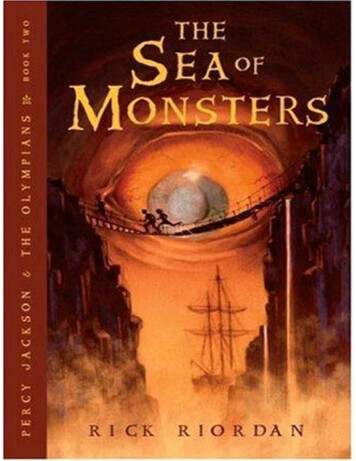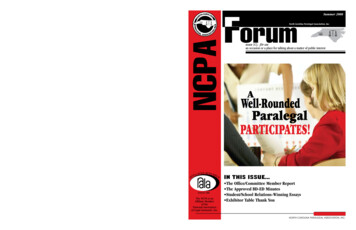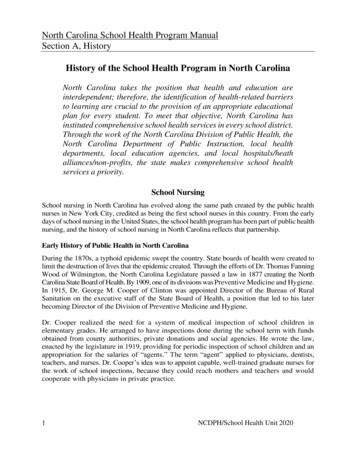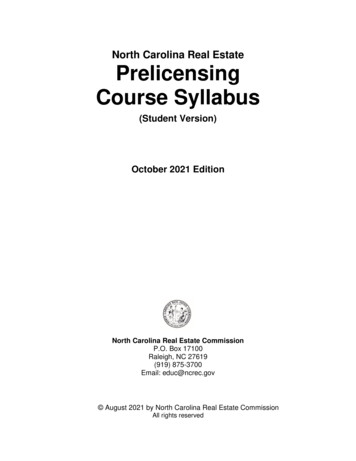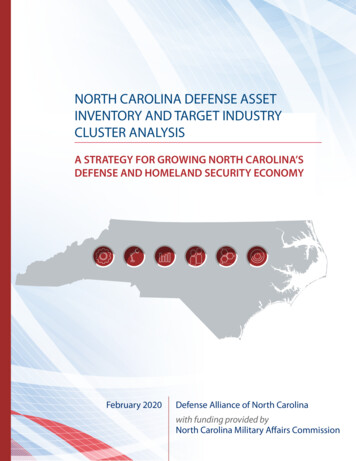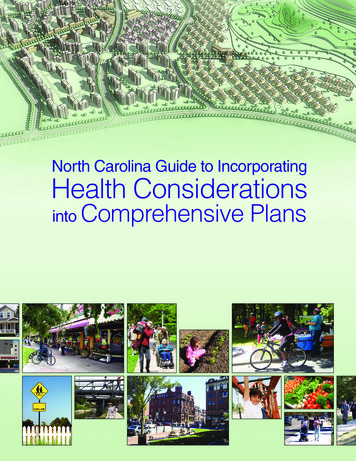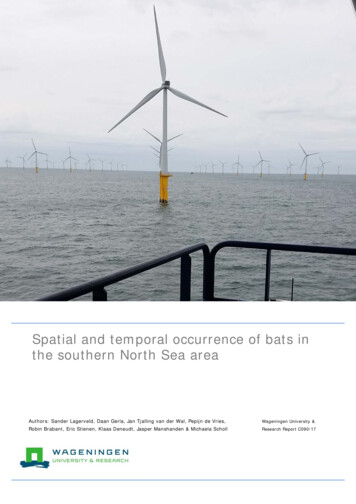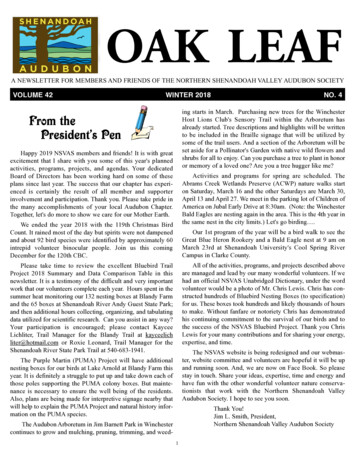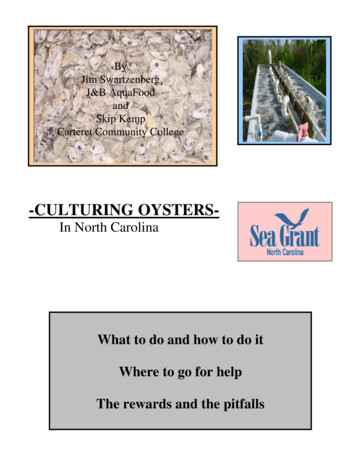
Transcription
ByJim SwartzenbergJ&B AquaFoodandSkip KempCarteret Community College-CULTURING OYSTERSIn North CarolinaWhat to do and how to do itWhere to go for helpThe rewards and the pitfalls
Table of ContentsIIntroduction . .1IIWhat are cultured oysters? . . 5IIIBusiness Requirements .7IVRaising and Acquiring Seed . .15VCulture Methods .21VIPredators, Pests, Competitors, Diseases, Defense Mechanisms .35VIIShellfish Sanitation 45VIII Markets and Marketing .49IXBusiness Investment .53XNatural Forces .61Appendix A — Dining Room Dermo Testing .69Appendix B — Hazard Area Critical Control Point .75Appendix C — Lifecycle of an oyster .85Appendix D — Marine Fisheries Rules and Regulations .87Appendix E — Sample Lease Management Plan . 103Appendix F — Small Business Plan .109Appendix G — Sources .111Appendix H — The Systems at a Glance .119
CULTURING OYSTERS IN NORTH CAROLINAIIntroductionYears of ResearchThis manual is the result of several years ofresearch and development by many people with varyingbackgrounds. It draws heavily on the experience of others. So in thatrespect, few of the ideas are really new. After all, culturing oysters canbe traced back to the early Romans who found that broken roof tiles that had fallen in thewater made good spat collectors. Since then, various cultures have modified thosetechniques, so that very little is new in this business — just a lot of adaptation andredesigning from the old ways.For purposes of this manual, oyster culture is distinguished from oysterrestoration and rehabilitation. Oyster culture is a sustainable enterprise, requiring ashellfish lease from the state, and is a private, for-profit commercial enterprise. Oysterrestoration and rehabilitation can be a private or state effort on public bottom, with noclaim of ownership and no intent of economic feasibility. If oyster reefs are harvested,they are not sustainable without additional planting; whereas, oyster culture involvesyearly planting and harvesting to maintain a sustained harvest.For North Carolina, you might say, it all started in the early1990s when Alfred “Al” Evans, a product design specialist from Tipper Tie, Inc. in Apex,NC, telephoned Philip “Skip” Kemp, then an extensionfrom North Carolina Sea Grant Advisory Service, atMembers of the specialistthat time based at the N.C. Aquarium on Atlantic Beach.Oyster CorpsTipper Tie produces and leases the machines that putaluminumclips on the mesh food bags, called chubs, that holdcarried homesuch as sausages and turkeys.the ladders to a food productsEvans had the idea that Tipper Tie’s food packagingtotal of 30 sites. materials could be used in the aquaculture industry forgrowing oysters. Although somewhat copied from themariculture techniques of Washington State and France, he thought his products might becompatible with some sort of new technique and design for growing East Coast oysters.They labored many months with the idea that they could come up with a systemthat would somehow resemble agricultural techniques used on a farm. This meant theyhad to design a mechanized plant-to-harvest system that would be user-friendly andadaptable to fairly large numbers. After all, the French, Japanese, and even Americanson the West Coast had been doing this sort of “oyster farming” for many years. So it justseemed natural, that it could be done on the East Coast, USA.1
CULTURING OYSTERS IN NORTH CAROLINAAfter about a year, they formed an “Oyster Corps” of volunteer leaseholders whoattended several workshops and helped assemble “chub ladders,” which were the finalproduct from the Evans/Kemp research project.Members of the Oyster Corps carried home the ladders to a total of 30 sites.With the blessing of the Division of Marine Fisheries, each participant was granted a 540square foot research water column sanctuary in which to float their oyster chub ladders.It was a good year for the test.There was ample rainfall and nohurricanes to tear up the chubs. As we’ll see later in this manual, these two factors arevital to the success of a good crop.The oysters were measured at two, five and fourteen-month intervals. At the bestsites, up to 68, 76, and 100 percent of the oysters sampled were of market size at the endof the test.Oyster growth varied considerably among the sites. The best sites appeared to bein the mid- to high-salinity ranges. However, the best guess at the time was that thegrowth was probably more closely related to a combination of the energy level and flowof the water, along with the food supply, than it was to the salinity. That debate still goeson.In any case, the project appeared to be a success, helping to speed up the growthrate of the oysters and to keep them healthy during peak disease seasons. Both Kemp andEvans, along with other marine scientists at Sea Grant, hoped this new method wouldcircumvent the effects of diseases such as dermo that kill oysters in their second year ofgrowth. Ongoing oyster culture research and development projects continue to add to theknowledge base for growing oysters.Now, more than a decade later, after many different configurations,starts and stops, successes and failures, this manual is being compiled to explain thesystems, evaluate their strengths and weaknesses, and outline how to implement themsuccessfully.If there is one key lesson to learn as you follow theFarmingprocess from start to finish, it is that farming oysters is not anoysters is not anexact science. It simply does not work the same way at allexact science.sites, at all times, under all conditions. Farming oysters is avery fluid and flexible process that one must master at aIt is a very fluidspecific place and time. Oyster farmers have to be ready toand flexiblechange midstream and adapt to varying factors. They have toprocess.expect that the same end product will not always be the finalresult and that there will be good years with bumper cropsand bad years when the crop is a total loss.The methods described in this manual are not the end-all and be-all of oysterfarming but perhaps a beginning. There has been enough research to provide a long listof lessons learned, of what to do and of what not to do, but even with the best of methods,the uncontrollable forces of Mother Nature tend to prevail. Stretches of drought thatresult in unusually high salinity for prolonged periods of time, for example, can wreakhavoc on any system of confinement that oysters are subjected to. During these times, thesea mosses and sea squirts tend to clog up the containers, slow down the growth of the2
CULTURING OYSTERS IN NORTH CAROLINAoysters, and invite such devastating predators and diseases as mud blisters (polydora) anddermo (Perkinsus marinus). The same forces that allow for a fast-growing oyster mostlikely have the same effect on the pathogens that spark the disease. When diseases attackin mass, a crop can be lost very quickly.Development of a fast-growing, disease resistant strain of oysters is primary forthe advancement of the industry. Even then, the new strain would be effective only in anaquaculture situation — and then only as long as the strain can be maintained.Researchers in Virginia toyed with the idea of a new disease-resistant strain torepopulate unproductive and lost public areas in the Chesapeake Bay, but their attemptsso far have ended in failure. They found that their “designer” oyster can augment andenhance the wild population, but then through spawning with wild stocks, it simplyreverts to the dominant genetic stock and soon dies out.Aquaculture is not intended to supplant the wild fishery orother techniques such as relay, tonging, and dredging, but rather to provide a sustainablesource of seafood for discriminating consumers. With enough people involved in thecultured oyster industry, the benefits shouldsoon spill over to the waters that surroundthe leases.This manual is a follow-on to onethat describes raising the seed titled, “FarmRaising of Oyster Seed.” Whether youraise your own seed or buy it ready toplant, it might be a good idea to look atboth manuals before starting a project.There is an accompanying video to “FarmRaising of Oyster Seed” that provides abrief overview of how some systems work.This manual examines several offbottom techniques for raising oysters,Figure 1: These triploid oyster seed, aboutincluding the rack and cage, oyster chub,two months old, will reach maturity and belong-line bag, and bottom/stackable cages.ready for market in about eighteen months.Though it uses the term “off-bottom,” somemethods that place the oysters on or very near the bottom, but in confined and controlledenvironments, adapt well to farming techniques.In addition, this manual presents the tools, techniques, economics, and otherbusiness aspects that go into a successful and profitable crop of oysters.3
CULTURING OYSTERS IN NORTH CAROLINAThis interactive manual, written in digital format, is intended to be user friendly.Itmay be printed from a personal computer with a CD-ROM drive and printer. The text comeswith helpful tools, which expand the scope and add links to many details unavailable in aprinted text. Though it may be printed out and maintained in a binder for ease of use, toexperience the full potential, it needs to be accessed on a computer with an Internet hookup.The reader will find several features helpful. Underlined links are embedded in the text,which can help the reader in several ways. There are a multitude of additional resources andinformation about oyster culture on the Internet. Many URL links are included for additionalinformation from the Internet such as Kemp’s Internet WebSpace. Bookmark links, such asthis link to the Introduction are included for ease of navigation through the manual and forcross-referencing. After you jump to a bookmark, you can return to page you just left by leftclicking on the back arrow on the tool bar.As with any digital text, you may use the word search feature if you are interested insome particular aspect of oyster culture. For example, if you want to learn more abouteconomic feasibility, use the word search feature to look up these references in the text. Clickon “Edit” in the Toolbar; then click on the binocular icon for “Find”; insert either “economic”or “feasibility” or both words in the dialog box, click, and find the references.To access Ask The Experts, you’ll need Microsoft Windows Media Player, whichyou may download at ers.aspx. Thenyou simply need to click on the icon, and a brief video will play on the machine. For example,click on [Buying Seed], and you’ll get a brief video overview of what to look for whenbuying oyster seed.We hope you’ll find this manual refreshing, different, and fun to follow. Andwe hope it will bring you to a new level of understanding about oyster culture in NorthCarolina. Perhaps this new understanding will lead you to get involved in this exciting, new,and profitable business.Icon KeyLinks to othersourcesLinks to URLAsk The Experts4
CULTURING OYSTERS IN NORTH CAROLINAIIWhat are cultured oysters?Farm-raised: Lite, Pure, and FreshThe oyster industry is rife with labels.From New York’s“Bluepoints” to Florida’s “Apalachacolas,” it seems that oyster loversfrom far and wide have a great urge to set their oysters apart from theothers.Most oysters could lay claim to the term “farm-raised” simply because they camefrom someone’s lease. There is no legal standard. The terms identifying one oyster fromanother are much abused and as subjective as “lite” in lite beer, “pure” in pure bottledwater, and “fresh” in farm fresh eggs.Such is true for “cultured” oysters. Any particular oyster, such as the Bluepoints,Apalachacolas, Stump Sounds, and others, may claim to be “cultured” along with theirregional label, but that doesn’t necessarilyThe terms identifying one mean they are cultured unless they are grownon a farm from hatchery raised seed.oyster from another are asThe name “Farm-raised Culturedsubjective as “lite” in lite Oysters” means the oysters were spawned in ahatchery and raised from seed in a controlledbeer, “pure” in pureenvironment. Though it is subject to abuse, thebottled water, and “fresh” label “cultured” should add value to an oysterbecause it will be a cut above what comes fromin farm fresh eggs.the wild. The cut above means that it will begrown and marketed by responsible growersand will be cleaner, fatter, more select, and adaptable for the half-shell market.Cultured oysters are better.The technique alone allows for a moreselective crop. Unlike their “bottom-raised” counterparts, the selection process begins inthe hatchery and continues throughout the life of the oysters, culminating at harvest.Good hatcheries “high grade” their stock from the larval stage on and discard the slowgrowers. Good farmers continue the grading process by picking out the doubles, thesmalls and the deformed. They end up with the top of the crop — all singles, uniform insize and easily cleaned oysters.A cultured oyster grows faster than a bottom-raised oyster because it can takeadvantage of the greater food and oxygen supply in the upper levels of the water. Thatextra nutrition allows it to reach maturity before many harmful diseases and organismscan affect or destroy it. In North Carolina that translates to a harvestable market size5
CULTURING OYSTERS IN NORTH CAROLINAoyster in 18 to 24 months depending on several growth factors such as food supply andannual rainfall. What is harvested is a healthier and better looking oyster.Dermo, for example, attacks and kills the oysters in about 24 months. Thoughsome dermo may be present in cultured oysters at the time of harvest, most oysters willhave been harvested before their second summer, and therefore will have averted theattack.Cultured oysters are always grown on leases in “open” or “conditionally open”waters with strict monitoring by N. C.Shellfish Sanitation. Because of their fastergrowth, cultured oysters have thinner shellsand therefore, greater meat yield per oyster.In most cases, “cultured” translates to“better handling.” Oyster farmers oftenmove their product from the water to thecooler and on to the consumer eitherdirectly or in a rapid pre-arrangedmarketing system. This means quickerturn-around time between harvest andconsumption.Figure 2: Cultured oysters of various sizes,Cultured oysters use modernone year old.farming techniques that are adaptable toboth large- and small-scale operations. This allows for a more regulated end crop, andthough these techniques may at times add labor to the overall process, the reward is acrop that commands a higher selling price at market.[Ask Matt Parker ]6
CULTURING OYSTERS IN NORTH CAROLINAIIIBusiness RequirementsLeasing, Location, Facilities and LaborThe obvious first step is to have a shellfish lease. In the case ofcultured oysters, most likely that will translate to a bottom lease with awater column lease amendment. The exception could be a bottom leasewithout the amendment if only bottom cages are to be used and if theyremain within six inches of the bottom.The advantage of leasing the water column is that it provides area off-bottom toestablish a nursery for seed, making handling a bit easier and saving money in theprocess. When small mesh nursery cages are placed on or near the bottom, they tend tofoul up quickly and require more maintenance to stay clean lest the seed will be stuntedor lost. Getting the oysters up into the water column will avert many problems.Fortunately, new proposed legislation promises to reduced the cost of a water columnlease amendment to an affordable price.A water column lease amendment allows the lessee to use the water from the topto bottom. So, a “water column” gives a person control of both the bottom and thecolumn of water above it, but the lessee still may not exclude or hinder normalnavigation. By that same rule, a boat may not interfere with the normal operations of thewater column holder.A water column is preferable for raising cultured oysters. Although it does notoffer unlimited control of the area, it does allow unlimited (legal) usage of the water fromtop to bottom. If someone wants to put a crab pot, net or other device in a water columnlease, for example, they could do so as long as it does not interfere with the shellfishoperation. Normally people leave such marked areas alone.A water column amendment goes along with abottomlease, and a bottom lease may be purchased from aA water columncurrent leaseholder, sub-leased or taken up anew.is preferable forLeases are treated as real property. They areraising cultured surveyed, mapped and recorded at the Division of MarineFisheries. They can be bought, sold, traded, willed or suboysters.leased. A person who is looking for a lease must ask,“Should I buy, sub-lease, or establish a new lease?”Buying an existing lease has its advantages. Many of the old leases wereestablished in prime areas, which would no longer be acceptable for a new lease. An7
CULTURING OYSTERS IN NORTH CAROLINAexisting lease does not require a new survey, and usually posts and signs are in place sothat the new owner would just have to repaint the old signs or add a few new ones. Oldleases have production records that can be verified by the Division of Marine Fisheries,and the transfer process is quite simple.On the other hand, many of the old leases are more than ten acres, and if you’rejust starting out, that may be a bit too much. In addition, many of the old leases containareas that are unsuitable for cultivation, such as thoroughfares. However, most of thosedrawbacks would be evident upon inspection of the area. It is essential to check theproduction record that comes with a prospective lease purchase. The new owner inheritsthat production, good or bad, and it may not be sufficient to renew the lease in the nearterm. In addition, the lease may be located in a marginal area prone to excessive closuresbecause of pollution. If so, the sanitation problems would most likely get worse overtime rather than better.Sub-leasing has much the same advantagesand disadvantages of buying an existing lease with aAn important nextfew exceptions. For someone just getting his or herstep is to call or visitfeet wet in the shellfish business and wanting to seewhat it’s like, perhaps a sub-lease agreement is anthe Division of Marineeasy way to “check things out.” Each sub-leaseFisheries, Resourceagreement is different. It would pay to know theEnhancement Section.owner of the lease, as well as the motivation behindsub-leasing the area rather than working or selling it.The biggest drawback is that situations change, andwithout an iron-clad agreement, the owner may decide to pull out at any time for avariety of reasons, leaving the sub-lease investment in jeopardy. A sub-lease agreementof less than five years isn’t worth much, unless it carries a good renewal clause.The good thing about a new lease is that it might be able to be located in front of aperson’s property or at some other site more convenient than anything available forpurchase. It can be whatever size and shape desired, that is up to 10 acres for oysterculture or 5 acres for clam culture.It takes three to six months, and sometimes even longer, to obtain a new lease, soit is wise to begin the process early and ensure that all the details are taken care of asthey come upIn North Carolina, the Marine Fisheries Commission — the regulatory body ofthe Division of Marine Fisheries — grants leases and makes regulations regarding leasedbottomland. According to regulations the Commission has enacted, new leases mustmeet the following standards: [See Appendix D, Marine Fisheries Rules andRegulations](A) They cannot contain a natural shellfish bed, which is defined as 10 bushels ormore per acre. Marine Fisheries representatives can usually determine thisupon initial inspection.(B) The lease area must not be closer than 100 feet from a developed shoreline,unless it is your own. (A lease may be excluded from this rule if a notarizedconsent is obtained from the riparian landowners. Beware, though, that ariparian landowner may rescind the consent at will.)8
CULTURING OYSTERS IN NORTH CAROLINA(C) The leaseholder must plant a minimum of 25 bushels of seed or 50 bushels ofcultch (or a combination of the two) per bottom lease acre or 100 bushels ofseed per water column lease acre every year.(D) The leaseholder must plant a minimum of 25 bushels of seed or 50 bushels ofcultch (or a combination of the two) per bottom lease acre or 100 bushels ofseed per water column lease acre every year.(E) The leaseholder must produce and market at least 10 bushels per acre from abottom lease or 40 bushels per acre from a water column lease per year.Having reviewed the rules and regulations and chosen an area for the lease, animportant next step is to call or visit the N.C. Division of Marine Fisheries ResourceEnhancement Section, obtain an application form, and ask for a free inspection. TheDivision will send a representative to look at and evaluate the area and perhaps discusswith you the possibilities of obtaining a lease. This “free” evaluation is a good ideabecause the next step is to submit an application form along with a non-refundable 100deposit. [Ask Craig Hardy, N.C. Marine Fisheries]By the time a deposit is placed, a prospective leaseholder should be fairly surethat he or she is going to get what they want. Otherwise, if the request for a lease isdenied, they will lose the 100 deposit. It is essential to talk to other leaseholders, andhave a good business plan in hand. The N.C. Shellfish Growers Association may be ableto provide the names of nearby members. Consult with an expert who can provide good,technical advice.[Ask Skip Kemp, Carteret Community College] Some areas aremore “lease friendly” than others. If you get into a turf war with someone who doesn’tlike leases, you could be in for some expensive litigation, and you could lose your 100application fee, so it’s good to know what lies ahead before moving on.A business plan is a roadmap to making money. There are plenty of referencesavailable at libraries and online, and community colleges usually have a small businesscenter that will provide youwith both technical andA business planhands-on assistance. Youcould use some of theprojections in this manual asis a road map to a starting point for your owncost and profit analysis.Again, it pays to talk tomakingmoney.others who have beenthrough the sameexperience.[Ask Matt Parker, Aquaculture Business Specialist] [View Sample SmallBusiness Plan]The prospective leaseholder should do a preliminary survey to evaluate theendemic shellfish population. A single clam, oyster, or scallop, regardless of size persquare yard, indicates borderline leaseable area. More than one shellfish per square yard,on average, will likely indicate a natural shellfish bed and will make the area unavailablefor leasing.The application must be accompanied by a map or diagram that shows thelocation of the lease with detail sufficient to permit on-site identification and location,and the prospective lease must be marked with posts at each corner. Two-inch PVC pipeis ideal for marking leases.A “management plan” that explains to the Division of Marine Fisheries just howyou plan to manage your lease must be drawn up and submitted with the application.They don’t care whether you make money or not, but they do care how you are going tooperate in the public trust waters, and they insist that you plant and produce the required9
CULTURING OYSTERS IN NORTH CAROLINAamount. So the management plan should be fairly comprehensive and should outlineyour methods and anticipated results. Details of the management plan are included in theMarine Fisheries rulebook, and a sample management plan is located in Appendix E,Sample Lease Management Plan.The completed application form, map, and management plan along with a 100application fee must be submitted to the Resource Enhancement Section, Division ofMarine Fisheries, P.O. Box 769, Morehead City, NC 28557-0769. If the application isaccepted, you will be asked to post signs provided by the Division on your corner stakesto let the public know of your intentions. In addition the Division will post a notice in thelegal section of the local paper. They will then hold a public hearing to see if there is anyopposition to the proposed lease. If any opposition is suspected, it may be a good idea tobring supporters who can speak on behalf of the proposed lease.If the lease is approved, it will need to be surveyed at the leaseholder’s ownexpense. One might expect to pay 400 to 800 for a survey depending on thecomplexity of the site.Good habitat and the right location can make a difference.It’simportant to know that one place is better than another, so a prospective leaseholder mustanswer the question, “Where is the best place to grow oysters?” A simple answer wouldbe “almost anywhere,” because the techniques presented in this manual usually can beadapted to the surroundings. But that’s not always the case, and a better answer is tolocate the lease in an area that offers the best habitat and practical location for thesituation. There are several factors that need to be taken into account:[Ask PatriciaFowler] Accessibility. It goes without saying that a site should be accessible, becauseif a person can’t get there, it doesn’t show much promise for leasing. Beingable to drive to the lease area is an advantage, but many good areas can beaccessed only by boat.Security. Poaching, vandalism and damage to the site can be minimized byadequate surveillance. If the site can be watched from the shore, especiallyfrom a home, surveillance becomes much easier.Salinity. Oysters can live at salinities as low as five or six parts per thousandfor a few days, but they thrive at salinities above 20 parts per thousand. Thesalinity is usually greater and more consistent in areas with active tidalflushing and a relatively small watershed. Areas that produce extremefluctuations in salinity should be avoided. Creeks or rivers draining largewatersheds are more likely to produce damaging freshwater influxes. Rainfallrunoff leaves large watersheds more slowly, and prolongs the exposure ofshellfish to low salinities and runoff pollution.Tides. Ideally the tidal range should be above 12 to 15 inches. Adequatetidal flushing ensures a mixing of the water, delivers food, removes wastesand stabilizes the salinity.Pollution. Avoid polluted waters and shy away from others frequently closedbecause of pollution. A check with N.C. Shellfish Sanitation can quickly tell10
CULTURING OYSTERS IN NORTH CAROLINA a prospective leaseholder about the status of the potential lease area. ( [AskPatricia Fowler]Substrate. Most bottom types can be adapted to oyster culture, but the idealis a firm bottom that will allow a person to walk freely around the area.Depth of water. It would be difficult, although not impossible, to operate inwater that is deeper than a person’s chest. Ideally, the water should be aboutwaist high. A water column lease should have enough water at low tide toprovide for flow at the bottom of the cages without being silted or sanded in.Dissolved oxygen. Oysters can stand relatively low dissolved oxygen levelsin water, but their growth will be poor, and they will become ever moresusceptible to disease. At low oxygen levels, the animals expend more energypumping water through their bodies to get the necessary oxygen. Thereforeless energy is available for growth. Usually water will contain adequatedissolved oxygen if it is in the upper portions of a water column or if it issubject to mixing by the tides, current, or winds.Flow. There must be sufficient water exchange to carry wastes away and tobring in food. Too much flow may wash away cages or chubs; too little flowmay cause excessive silting. The ideal lease would provide plenty of waterflow to transport food, for example near a creek or marsh that ebbs and flowswith the tides.Turbulence. Areas open to long distances where waves can build up andwash across the lease and wash away cages and such are suspect and probablyshould be avoided unless a solid plan of dealing with the situation is in place.Food sources. The ideal lease would provide a good source of food for thecrop and plenty of water flow to transport that food, for example near a creekor marsh that would ebb and flow over the lease with the tidal exchange.As in any venture of this sort, there has to be a place toconduct business, and in thecase of maricultured oysters, thereneeds to be a facility on shore tohandle product. The place to conductbusiness can be as simple as a homeoffice, but the facility ashore may needto be a bit more elaborate dependingon the extent to which a businesswants to get involved.At a minimum, the shore areashould include a place to dock orlaunch a boat and unload product. Itshould have electricity, three phase, ifFigure 3: A shore-side facility can allow for easepossible, and ideally space for a walkof handling the product from harvest to market.in cooler and a work area to uncage,wash, sort, and pack oysters. Withoutthese accessories, a farmer would be doomed to selling the product as it comes out of the11
CULTURING OYSTERS IN NORTH CAROLINAwater and probably to a middleman at a lesser price. That’s not necessarily a bad idea,and many a start-up operation may be wise to work that way. The bottom line, though, isthe better equipped the operation, the more options become available for handlingproduct.With a shore-side facility such as what has just been described, a farmer couldinstall
that describes raising the seed titled, "Farm Raising of Oyster Seed." Whether you raise your own seed or buy it ready to plant, it might be a good idea to look at both manuals before starting a project. There is an accompanying video to "Farm Raising of Oyster Seed" that provides a brief overview of how some systems work.
